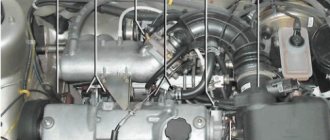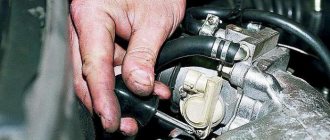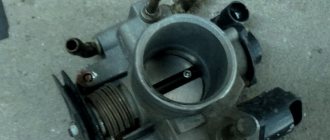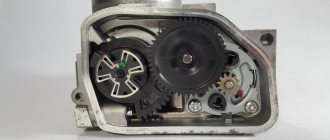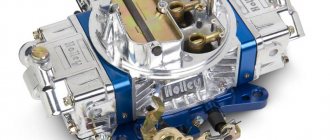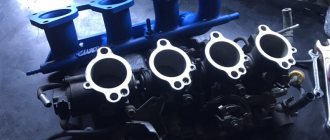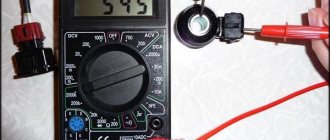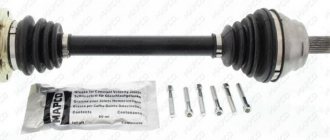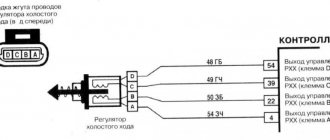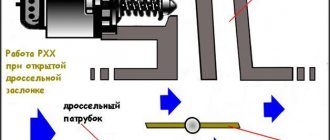The throttle valve is a structural element of the fuel system of a car with a gasoline internal combustion engine, regulating the flow of air masses and the formation of the air-fuel mixture. This element of the intake system is located between the manifold and the air filter. The throttle is one of the main components of a car's power system.
Throttle valve
The throttle valve is a kind of air valve that allows you to control the pressure in the system. If the valve is open, the pressure level tends to atmospheric, and when closed, it decreases, approaching vacuum. Thus, the throttle valve also regulates the operation of the vacuum brake booster. This means that the smaller the valve opening angle, the lower the speed.
Throttle valve device
The throttle valve is a round plate that has the ability to rotate 90 degrees around itself - this is a cycle from opening to closing. It is located in a housing containing:
- Drive - mechanical or electric;
- Position sensor - throttle potentiometer;
- Idle speed regulator.
Together, all these components form the throttle assembly or throttle body.
The damper body is quite complicated. After all, it itself is part of the cooling system. It is the throttle assembly that opens the channels through which coolant circulates. Equipping the body with special pipes connected to the ventilation system and the fuel vapor recovery system makes the design even more complex. This system should be studied in more detail.
Code P0122 Low signal level of the Lada Vesta throttle position sensor.
Code P0122 is entered if:
- ignition on;
- the throttle position sensor signal voltage (ADC parameter “ Throttle sensor voltage 1 ”) is less than 0.25 V for 0.12 s.
The malfunction indicator lights up 5 s after the fault code appears.
Description of checks.
The sequence corresponds to the numbers on the card.
- Using a diagnostic tool, it is checked whether code P0122 is active at the time of diagnosis. If only code P0122 is detected, then the fault must be looked for in the signal circuit of TPS A. If codes P0122 and P0222 are detected at the same time, then the fault must be looked for in the power circuit of TPS A and TPS B.
- The circuit is checked from contact “X1.2/G2” of the controller to contact “3” of the electronic protection device.
- The controller is checked: when you bridge contacts “3” and “5” of the block to the EDS using a probe, the TPS A signal on the diagnostic device should change.
- The circuit is checked from contact “X1.2/E3” of the controller to contact “5” of the electronic protection device.
- The controller is checked: pin “5” of the block to the EDS should receive a reference voltage of 5 V from the controller.
Idle speed control
Throttle valve on a car
Using the idle speed regulator, the required crankshaft rotation speed is maintained with the throttle completely closed. For example, if the motor heats up or the load increases, additional equipment is connected to the process.
The regulator is designed as follows: a housing in which a stepper electric motor is attached, connected to a conical needle. While the engine is running at idle speed, the needle, like a piston, regulates the cross-sectional area of the air channel.
Troubleshooting Methods
Typically, all problems with the throttle body are solved by cleaning the throttle body. To clean the air filter, you can usually simply disconnect the air filter pipe. After this, you need to spray the engine protection with an aerosol to clean carburetors or injectors. This substance will dissolve plaque. And after this, the plaque can be removed with a simple rag or paper napkin.
To solve more serious problems, you need to remove the throttle valve assembly.
, then remove the rubber seals and spray again with the same aerosol. If the remote control is mechanical and does not have built-in electronics, then it would be wise to put it in a container with gasoline overnight.
It is worth remembering that before cleaning the throttle assembly, you need to make sure that cleaning will not harm it, since there are valves that are strictly contraindicated for cleaning!
At any service station you can clean the engine protection quite quickly and relatively inexpensively. The cost of the work may depend on its complexity and the degree of contamination of the system.
If the problem with the throttle concerns not the mechanical control, but the electronic one, then the problems are solved after diagnostics; perhaps the throttle malfunction will be solved after adjusting or replacing the throttle position sensor.
Potentiometer
In other words, the potentiometer changes the opening angle of the damper and thereby affects the controller. When the damper is closed, the voltage does not exceed 0.7 V, and when fully open it reaches 4V. This is how fuel supply is controlled.
If the throttle valve stops responding to impulses emanating from the position sensor, the following breakdowns may occur:
- Floating speed when the engine is running. Increased idle speed;
- The engine stalls when switching to neutral;
- Uncontrolled fuel consumption;
- The engine is running at half power;
- The CHEK light is on - check if the throttle valve is working correctly.
How to adapt and train the electronic throttle of Lada Vesta.
If the electronic throttle body or ECM is replaced, or the controller is reset using the scan tool (Function Test; ECU Reset with Initialization mode), the Throttle Zero Adaptation procedure must be performed.
To do this, with the car standing, you need to turn on the ignition, wait 30 seconds, turn off the ignition, and wait until the main relay turns off.
Adaptation will be interrupted if:
- the engine turns over;
- the car is moving;
- the accelerator pedal is pressed;
- engine temperature is below 5 °C or above 100 °C;
- Ambient temperature is below 5 °C.
If the electric throttle actuator is de-energized, the throttle valve is held in the Limp home position (6-7%) using direct and return springs.
How to fix the problem
If you suspect that the throttle valve is faulty, you need to check the entire assembly where it is attached. To do this, strictly follow the following algorithm:
- Disconnect the battery negative terminal.
- It is necessary to drain the liquid from the cooling system.
- Remove the hoses from the throttle body.
- Remove the damper drive cable.
- Release the potentiometer from the pads and the idle speed control.
- Remove the throttle assembly.
- Check the condition of the throttle valve gasket and other components of the assembly.
- If necessary, replace some components or the entire assembly.
- Reassemble the structure in reverse order.
After you have installed the unit in place, you need to check the tightness of the cooling system, where you refilled the liquid. There should be no drops or runs.
A mechanical failure occurred with the owner of a Lada Vesta.
I drove for a little while after buying the car and during kickdown the car did not pick up speed and went into emergency mode, to which an acquaintance of the former owner said it was drizzling, the ABS sensor took my word for it, but in vain. And at 130,000 km I was already forced to urgently go to the service center to look for the fault; in the end, the reason turned out to be in the throttle valve because... Manufacturers made plastic gears on them and over time they ground down and broke off in some places.
SUBSCRIBE TO NEW ARTICLES VIA VK GROUP!
Subscribe
Damper adjustment
In order for the throttle valve to work like a clock, its sensor must be periodically adjusted. To do this, follow a few simple steps:
- The ignition is turned off to move the valve to the closed position.
- The sensor connector is de-energized.
- The sensor is adjusted using a 0.4 mm probe located between the screw and the lever.
To check the serviceability of the sensor, the voltage level is measured using an ohmmeter. If voltage is detected, the sensor should be replaced. In the opposite situation, you can continue to adjust the sensor.
To do this, the damper rotates until you see the same indicators that are written in the car's passport. Do not forget to check the tightness of the screws and nuts after adjustment; they could have become loose during the process.
As you know, the fuel system of a car is its vitality. If it is even slightly damaged, the car may unpleasantly surprise you at the most inopportune moment. If the throttle valve or another element of the assembly fails, the consequences can be disastrous. Therefore, it is much better not to skimp on car diagnostics if there is the slightest suspicion of a malfunction. Remember - safety on the road comes first.
History of creation
A system for mixing gasoline vapor with air, including a mechanical throttle valve, was invented in 1872 by engineers Gottlieb Daimler and Wilhelm Maybach. In this form, the system existed for more than a century, until the German company Bosch developed an electronic version of the throttle.
The damper mechanism of the electronic throttle assembly needs periodic cleaning, as fine dust gets into it, which even a very high-quality filter cannot filter out.
For the first time, an electronic throttle was used for a racing car. Back in 1985, Volkswagen was experimenting with the second generation Golf, trying to make it a racing car. To achieve this, the Golf was equipped with two engines at once, and the E-Gas system was used to synchronize their powers. The throttle on one of them was controlled mechanically, and for the other an electric drive was used, which synchronized the position of the damper. As a result, it was possible to achieve a total engine power of 500 horsepower, and acceleration to hundreds took 3.4 seconds. Not a bad result for 1985!
Electronic throttle became available for civilian vehicles at almost the same time. Manufacturers such as Saab, Mercedes-Benz and BMW equip their vehicles with electrically operated dampers. However, they have not yet been able to completely displace the mechanical drive, which is simple and cheap to produce.
Signs of a malfunction of the TPS
Like any mechanism in a car, the throttle position sensor also has this feature and can break down with use. No part lasts forever, so sooner or later it will break. To correctly detect a breakdown, you should know what signs to look out for. Now we list the most basic symptoms:
- First of all, if you suspect something is wrong with the throttle position sensor, first carefully inspect the engine. If you suspect that the speed drops significantly at some moments, then this already indicates that the sensor is not functioning properly. If everything is controlled by an electronic computer, then you should contact the service and do a software reset.
- Also, a breakdown of the sensor is often indicated by a situation when you suddenly release the accelerator, and at this time the engine immediately stalls. If this happens, then this indicates a complete breakdown of the module; it should be replaced immediately so as not to provoke new problems.
- During intense acceleration, your speed drops significantly by 5-10 kilometers per hour. Often drivers think that this fuel is not supplied and go to a gas station, but in fact in 80 percent of cases it is simply a breakdown of the TPS.
- Have you noticed that while driving the car does not respond to movements of the gas pedal. In this case, you need to stop the car immediately, otherwise it may lead to an accident. The problem may be hidden in a complete breakdown of the TPS, sometimes there may be some kind of mechanical damage to the damper, and therefore it cannot close tightly.
- During idle, the speed stops at 2000-3000 rpm and hangs at this level for a long time.
Based on all of the above, we can safely say that all symptoms directly indicate improper engine operation. Therefore, it is worth remembering that if you notice malfunctions in the engine, the first thing you should do is check the throttle position sensor. Below we will describe in detail how to check this sensor, we will look at the example of VAZ cars, their design is identical.
Video about signs of TPS malfunction
Recommendations for choosing TPS
Quite often, car manufacturers install a cheap film-resistive throttle sensor. Such a mechanism will not work for a long time, and very soon symptoms of its malfunction will begin to appear.
Therefore, when replacing, it is recommended to use a non-contact sensor, which is more expensive, but is more reliable in operation and has a long service life. Its working principle is based on the magnetoresistive effect.
Sources
- https://autoleek.ru/sistemy-dvigatelja/vpusknaya-sistema/drosselnaya-zaslonka.html
- https://VazNeTaz.ru/drosselnaya-zaslonka
- https://seite1.ru/zapchasti/drosselnaya-zaslonka-ustrojstvonaznacheniechistkaremont/.html
- https://avtozam.com/elektronika/sensor/kak-proverit-dpdz/
- https://tolkavto.ru/raznoe/drosselnaya-zaslonka-eto-chto-takoe.html
- https://seite1.ru/zapchasti/datchik-drosselnoj-zaslonki-prednaznachenietipyvidyneispravnostifoto/.html
- https://avtoskill.ru/remont-obsluzhivaniye/kak-proverit-datchik-polozheniya-drosselnoy-zaslonki-dpdz.html
- https://AvtoNov.com/%D0%BF%D1%80%D0%B8%D0%B7%D0%BD%D0%B0%D0%BA%D0%B8-%D0%BD%D0%B5% D0%B8%D1%81%D0%BF%D1%80%D0%B0%D0%B2%D0%BD%D0%BE%D1%81%D1%82%D0%B8-%D0%B4%D0 %BF%D0%B4%D0%B7/
- https://autofakty.com/proverka-datchika-polozheniya-drosselnoj-zaslonki-dpdz/
- https://rad-star.ru/pressroom/articles/neispravnosti-datchika-drosselnoj-zaslonki/
- https://okeydrive.ru/datchik-polozheniya-drosselnoj-zaslonki-kak-proverit-zamenit-otregulirovat/
- https://motorsguide.ru/system/datchik-polozheniya-drosselnoj-zaslonki
Methods for diagnosing TPD
The most common test of the sensor is to measure resistance or voltage at various throttle positions (closed, half-open, and fully open). We will perform testing using the voltage measurement function.
- Open the hood and remove the air filter assembly where it connects to the throttle body.
- Inspect the throttle plate and the throttle body walls around it.
* If you see carbon deposits on the walls or under the choke plate, clean this assembly using carburetor cleaner (carb cleaner) and a clean rag. The surface must be completely clean. Carbon deposits and dirt can prevent the throttle valve from closing and moving freely.
- Locate the TPS mounted on the side of the throttle body. The sensor is made in the form of a small plastic block with a three-wire connector.
